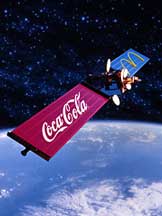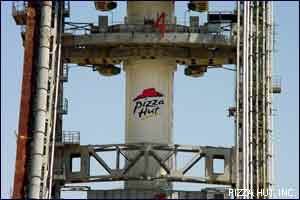There will always be marketers who believe with all their heart that the biggest advertisement is the best advertisement.
It’s why there we travel to work everyday flanked by billboards, and why places like Times Square and Japan’s so-called ‘Sleepless Town’.
It’s also why, since 1990, companies have been looking for ways to send their brands into the stratosphere and beyond! Here’s how a few have already managed such a giant leap.
1990 – Soyuz TM-11
In 1990, Russia launched the Soyuz TM-11 as part of their 11th expedition to the Mir Space Station.
On board was Japanese reporter Toyohiro Akiyama, whose employer, Tokyo Broadcasting System, had paid for both his seat and a TBS logo on the launch vehicle. Sensing an opportunity, Sony, Unicharm, and Otsuka Pharmaceutical also had their logos emblazoned on the craft.
1993 – Space Billboard
Next up were the Americans. Specifically, Space Marketing Inc., a company proposing the idea of a 1km-squared, illuminated Space Billboard that would be launched into low orbit, where it would be visible from Earth.
It was a ludicrous idea. The Space Billboard would have been as large and as bright as the moon, and would have been under constant threat of being destroyed by space debris.
The project inspired congress to ban all U.S. advertising in space, though this was later amended to only be relevant to advertising that would be considered obtrusive.
1997 – Tnuva
In 1997, Israeli milk and dairy company Tnuva produced the first television commercial shot in space.
It stars Mir crew commander Vasily Tsibliyev as himself, as he requests “Israeli milk” to be sent up to the space station.
Created for $450,000 after a nine-month pre-production process, the president of Tnuva told media he was extremely happy with the result, as it highlighted the company’s commitment to quality (the milk had to be completely free of bacteria to be sent into space).
2000/2001 – Pizza Hut
Most recently, Pizza Hut had two forays into the realm of space advertising.
The first came in 2000, when the company had their logo branded on a Russian proton rocket.
The second, and more extraordinary idea, came the following year, when they delivered pizza to the International Space Station in a vacuum-sealed container.
Why, you ask? It’s not like anyone could see the logo, nor was it likely the Russians would make a habit of delivering pizza to space whenever the cosmonauts got a craving for it.
Well, it is estimated that the combined press value the stunts received totalled $250 million worldwide.
—
It’s been over a decade since ‘spacevertising’ last made the news, but there may be a future for it yet.
As funding for space programs continues to dwindle across the globe, those who nevertheless plan to continue endeavours into space exploration are looking for new ways to fund their projects.
Only over the last couple of years, HAKUTO (formerly White Label Space), one of the team’s competing for Google’s LunarX $30 million prize for landing a privately-funded rover on the moon, said they would be partially funding their design through commercial advertising.




Hi Mitch, I truly enjoyed reading this article. It is of interest to me (Melbournian) because I am part of a real project in March 2023 launching a cubesat in space on a spaceX rocket that will display commercial ads and NFT’s in space (space display). This project is the first of its kind. The complete project is being put together by Geometric Eneregy Corp GEC Canada and spaceX. You can check it out. I would love to learn more about the estimated total press value PIZZAHUT was able to capture after 2000/2001 launch. Look forward to hearing from you mate.